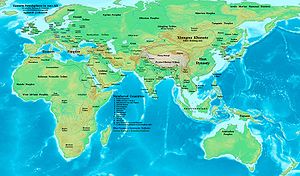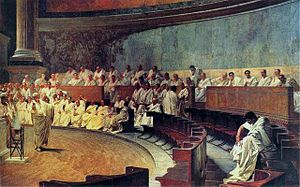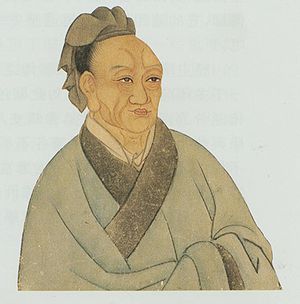
1st century BC
Did you know...
SOS Children volunteers helped choose articles and made other curriculum material Sponsor a child to make a real difference.
| Millennium: | 1st millennium BC |
|---|---|
| Centuries: |
|
| Decades: | 90s BC 80s BC 70s BC 60s BC 50s BC 40s BC 30s BC 20s BC 10s BC 0s BC |
| Categories: | Births – Deaths Establishments – Disestablishments |
The 1st century BC, also known as the last century BC, started on the first day of 100 BC and ended on the last day of 1 BC. The AD/BC notation does not use a year zero; however, astronomical year numbering does use a minus sign, so "2 BC" is equal to "year -1". This is the 99th century in the Holocene calendar; it spans the years 9,901 to 10,000. 1st century AD (Anno Domini) follows.
Overview
In the course of the century all the remaining independent lands surrounding the Mediterranean were steadily brought under Roman control, being ruled either directly under governors or through puppet kings appointed by Rome. The Roman state itself was plunged into civil war several times, finally resulting in the marginalization of its 500 year old republic, and the embodiment of total state power in a single man—the emperor.
The internal turbulence that plagued Rome at this time can be seen as the last death throes of the Roman Republic, as it finally gave way to the autocratic ambitions of powerful men like Julius Caesar, Mark Antony and Octavian. Octavian's ascension to total power as the emperor Augustus is considered to mark the point in history where the Roman Republic ends and the Roman Empire begins. Some scholars refer to this event as the Roman Revolution. It is believed that the birth of Jesus, the central figure of Christianity took place at the close of this century.
In the eastern mainland, the Han Dynasty began to decline and the court of China was in chaos in the latter half of this century. Trapped in a difficult situation, the Xiongnu had to begin emigration to the west or attach themselves to the Han.
Events
- 92 BC: Lucullus invades Armenia, setting off the centuries long Roman-Persian Wars.
- 81 BC: Sulla is appointed dictator of the Roman state, and brings about major reforms.
- 73 BC: A slave rebellion led by the escaped gladiator Spartacus leads to the Third Servile War.
- 63 BC: Pompey captures Jerusalem, and establishes Roman annexation of Judea as a client kingdom. He also permanently abolishes Seleucid Syria. King Judah Aristobulus II removed from power, while his brother John Hyrcanus II becomes king under Roman suzerainty.
- 57 BC: Silla is founded in southeastern Korea (traditional date according to Samguk Sagi, a 12th century historical document).
- 53 BC: The Parthians defeat the Romans under Crassus in the Battle of Carrhae.
- Mid 1st century BC – East torana of the Great Stupa at Sanchi, is made. Early Andhra period. According to an inscription, it is sculpted by ivory carvers from the nearby town of Vidisha.
- January 10, 49 BC: Julius Caesar crossed the Rubicon river, precipitating war with Rome.
- 44 BC: Julius Caesar murdered.
- Second half of 1st century BC – Chaitya hall at Karli, India, Maharashtra, is made. Early Andhra period.
- 37 BC: Goguryeo is founded in southern Manchuria (traditional date according to Samguk Sagi).
- 31 BC: Roman Civil War: Battle of Actium—Off the western coast of Greece, forces of Octavian defeat troops under Mark Antony and Cleopatra.
- 27 BC: The Roman Senate votes Octavian the title of Augustus. Augustus eventually assumes all authority formerly held by the Roman senate becoming the first emperor. The Roman state is henceforth known as the Roman Empire, and the period from 27 BC to AD 305 as the Principate.
- 18 BC: Baekje is founded in midwestern Korea (traditional date according to Samguk Sagi).
- c. 6 BC – 4 BC: Birth of Jesus of Nazareth (see Chronology of Jesus' birth and death, Anno Domini, and Common Era for further details).
- Openwork box lid, from Cornalaragh County, Monaghan, Ireland, is made. La Tène period. (approximate date) It is now kept at National Museum of Ireland, Dublin.
- Late 1st century BC – Garden Scene, detail of a wall painting from the Villa of Livia at Prima Porta, is made. It is now kept at Museo Nazionale Romano, Rome.
Significant people
- Burebista, king of Dacia
- Catiline, attempted to overthrow Roman Republic
- Cato the Younger, politician and statesman
- Caesar Augustus, Roman emperor
- Cicero, Roman politician and writer
- Cleopatra VII of Egypt, Egyptian ruler
- Herod the Great, king of Judea
- Hillel the Elder, Jewish rabbi
- Horace, Roman poet
- Jesus of Nazareth, The Son of God in various beliefs
- Jing Fang, Chinese mathematician and music theorist
- Julius Caesar, Roman general and politician
- Livy, Roman historian
- Lucius Licinius Lucullus, Roman general and politician
- Lucretius, Roman philosopher
- Marcus Antonius, Roman politician
- Marcus Licinius Crassus, Roman general and politician
- Marcus Junius Brutus, Caesar's adopted son, supposedly killed him
- Marcus Vipsanius Agrippa, Roman statesman and general
- Marcus Vitruvius Pollio Roman writer, architect and engineer
- Pompey Magnus, Roman general and politician
- Quintus Sertorius, Roman statesman and general
- Sextus Pompeius, Roman general and son of Pompey
- Ptolemy XIII of Egypt, drowned in Nile
- Ovid, Roman poet
- Virgil, Roman poet
- Spartacus, gladiator and insurgent leader of the Third Servile War
- Sima Qian, Chinese historian, father of Chinese historiography
- Tigranes the Great, king of Armenia
Inventions, discoveries, introductions
- Sunspots, first recorded by Chinese
- The Antikythera mechanism is made
- The first dome was built by the Romans
- Glass blowing is invented in Roman Syria
- The Chinese Ji Jiu Pian dictionary published in 40 BC during the Han Dynasty is the earliest known reference to the hydraulic-powered trip hammer device.
Decades and years
|
|||||||||||||||||||||||||||||||||||||||||||||||||||||||||||||||||||||||||||||||||||||||||||||||||||||||||||||||||||||||||||||||||||||||||
|
||||||||||||||||||||||||||||||||||||||||||||||||||||||||||||||||||||||||||||||||||||||||||||||||||||||||||||||||||||||||||||||





